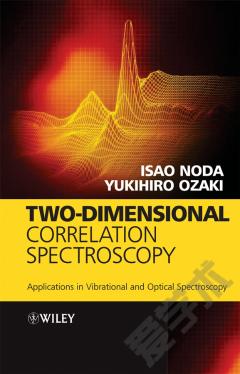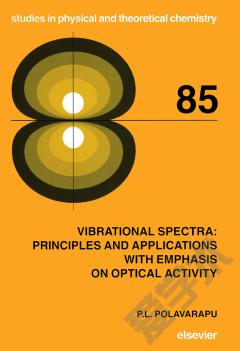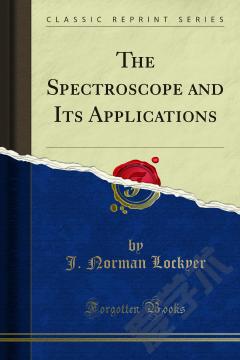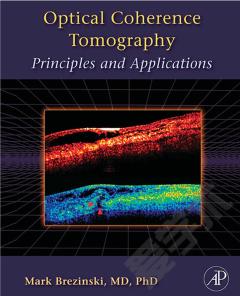Two-Dimensional Correlation Spectroscopy —— Applications in Vibrational and Optical Spectroscopy
----- 二维相关光谱:震动与光学光谱学应用
Preface.Acknowledgements.1 Introduction.1.1 Two-dimensional Spectroscopy.1.2 Overview of the Field.1.3 Generalized Two-dimensional Correlation.1.3.1 Types of Spectroscopic Probes.1.3.2 External Perturbations.1.4 Heterospectral Correlation.1.5 Universal Applicability.2 Principle of Two-dimensional Correlation Spectroscopy.2.1 Two-dimensional Correlation Spectroscopy.2.1.1 General Scheme.2.1.2 Type of External Perturbations.2.2 Generalized Two-dimensional Correlation.2.2.1 Dynamic Spectrum.2.2.2 Two-dimensional Correlation Concept.2.2.3 Generalized Two-dimensional Correlation Function.2.2.4 Heterospectral Correlation.2.3 Properties of 2D Correlation Spectra.2.3.1 Synchronous 2D Correlation Spectrum.2.3.2 Asynchronous 2D Correlation Spectrum.2.3.3 Special Cases and Exceptions.2.4 Analytical Expressions for Certain 2D Spectra.2.4.1 Comparison of Linear Functions.2.4.2 2D Spectra Based on Sinusoidal Signals.2.4.3 Exponentially Decaying Intensities.2.4.4 Distributed Lorentzian Peaks.2.4.5 Signals with more Complex Waveforms.2.5 Cross-correlation Analysis and 2D Spectroscopy.2.5.1 Cross-correlation Function and Cross Spectrum.2.5.2 Cross-correlation Function and Synchronous Spectrum.2.5.3 Hilbert Transform.2.5.4 Orthogonal Correlation Function and Asynchronous Spectrum.2.5.5 Disrelation Spectrum.3 Practical Computation of Two-dimensional Correlation Spectra.3.1 Computation of 2D Spectra from Discrete Data.3.1.1 Synchronous Spectrum.3.1.2 Asynchronous Spectrum.3.2 Unevenly Spaced Data.3.3 Disrelation Spectrum.3.4 Computational Efficiency.4 Generalized Two-dimensional Correlation Spectroscopy in Practice.4.1 Practical Example.4.1.1 Solvent Evaporation Study.4.1.2 2D Spectra Generated from Experimental Data.4.1.3 Sequential Order Analysis by Cross Peak Signs.4.2 Pretreatment of Data.4.2.1 Noise Reduction Methods.4.2.2 Baseline Correction Methods.4.2.3 Other Pretreatment Methods.4.3 Features Arising from Factors other than Band Intensity Changes.4.3.1 Effect of Band Position Shift and Line Shape Change.4.3.2 Simulation Studies.4.3.3 2D Spectral Features from Band Shift and Line Broadening.5 Further Expansion of Generalized Two-dimensional Correlation Spectroscopy - Sample-Sample Correlation and Hybrid Correlation.5.1 Sample-Sample Correlation Spectroscopy.5.1.1 Correlation in another Dimension.5.1.2 Matrix Algebra Outlook of 2D Correlation.5.1.3 Sample-Sample Correlation Spectra.5.1.4 Application of Sample-Sample Correlation.5.2 Hybrid 2D Correlation Spectroscopy.5.2.1 Multiple Perturbations.5.2.2 Correlation between Data Matrices.5.2.3 Case Studies.5.3 Additional Remarks.6 Additional Developments in Two-dimensional Correlation Spectroscopy - Statistical Treatments, Global Phase Maps, and Chemometrics.6.1 Classical Statistical Treatments and 2D Spectroscopy.6.1.1 Variance, Covariance, and Correlation Coefficient.6.1.2 Interpretation of 2D Disrelation Spectrum.6.1.3 Coherence and Correlation Phase Angle.6.1.4 Correlation Enhancement.6.2 Global 2D Phase Maps.6.2.1 Further Discussion on Global Phase.6.2.2 Phase Map with a Blinding Filter.6.2.3 Simulation Study.6.3 Chemometrics and 2D Correlation Spectroscopy.6.3.1 Comparison between Chemometrics and 2D Correlation.6.3.2 Factor Analysis.6.3.3 Principal Component Analysis (PCA).6.3.4 Number of Principal Factors.6.3.5 PCA-reconstructed Spectra.6.3.6 Eigenvalue Manipulating Transformation (EMT).7 Other Types of Two-dimensional Spectroscopy.7.1 Nonlinear Optical 2D Spectroscopy.7.1.1 Ultrafast Laser Pulses.7.1.2 Comparison with Generalized 2D Correlation Spectroscopy.7.1.3 Overlap Between Generalized 2D Correlation and Nonlinear Spectroscopy.7.2 Statistical 2D Correlation Spectroscopy.7.2.1 Statistical 2D Correlation by Barton II et al.7.2.2 Statistical 2D Correlation by Sa sic and Ozaki.7.2.3 Other Statistical 2D Spectra.7.2.4 Link to Chemometrics.7.3 Other Developments in 2D Correlation Spectroscopy.7.3.1 Moving-window Correlation.7.3.2 Model-based 2D Correlation Spectroscopy.8 Dynamic Two-dimensional Correlation Spectroscopy Based on Periodic Perturbations.8.1 Dynamic 2D IR Spectroscopy.8.1.1 Sinusoidal Signals8.1.2 Small-amplitude Perturbation and Linear Response.8.1.3 Dynamic IR Linear Dichroism (DIRLD).8.1.4 2D Correlation Analysis of Dynamic IR Dichroism.8.2 Dynamic 2D IR Dichroism Spectra of Polymers.8.2.1 Polystyrene/Polyethylene Blend.8.2.2 Polystyrene.8.2.3 Poly(methyl methacrylate).8.2.4 Human Skin Stratum Corneum.8.2.5 Human Hair Keratin.8.2.6 Toluene and Dioctylphthalate in a Polystyrene Matrix.8.2.7 Polystyrene/Poly(vinyl methyl ether) Blend.8.2.8 Linear Low Density Polyethylene.8.2.9 Poly(hydroxyalkanoates).8.2.10 Block Copolymers.8.2.11 Summary.8.3 Repetitive Perturbations Beyond DIRLD.8.3.1 Time-resolved Small Angle X-ray Scattering (SAXS).8.3.2 Depth-profiling Photoacoustic Spectroscopy.8.3.3 Dynamic Fluorescence Spectroscopy.8.3.4 Summary.9 Applications of Two-dimensional Correlation Spectroscopy to Basic Molecules.9.1 2D IR Study of the Dissociation of Hydrogen-bonded N-Methylacetamide.9.2 2D NIR Sample-Sample Correlation Study of Phase Transitions of Oleic Acid.9.3 2D NIR Correlation Spectroscopy Study of Water.9.4 2D Fluorescence Study of Polynuclear Aromatic Hydrocarbons.10 Generalized Two-dimensional Correlation Studies of Polymers and Liquid Crystals.10.1 Temperature and Pressure Effects on Polyethylene.10.2 Reorientation of Nematic Liquid Crystals by an Electric Field.10.3 Temperature-dependent 2D NIR of Amorphous Polyamide.10.4 Composition-based 2D Raman Study of EVA Copolymers.10.5 Polarization Angle-dependent 2D IR Study of Ferroelectric Liquid Crystals.11 Two-dimensional Correlation Spectroscopy and Chemical Reactions.11.1 2D ATR/IR Study of Bis(hydroxyethyl terephthalate) Oligomerization.11.2 Hydrogen-Deuterium Exchange of Human Serum Albumin.12 Protein Research by Two-dimensional Correlation Spectroscopy.12.1 Adsorption and Concentration-dependent 2D ATR/IR Study of beta-Lactoglobulin.12.2 pH-dependent 2D ATR/IR Study of Human Serum Albumin.12.2.1 N Isomeric Form of HAS.12.2.2 N-F Transition Region of HAS.12.3 Aggregation of Lipid-bound Cytochrome c.13 Applications of Two-dimensional Correlation Spectroscopy to Biological and Biomedical Sciences.13.1 2D NIR Study of Milk.13.2 2D IR Study of Synthetic and Biological Apatites.13.3 Identification and Quality Control of Traditional Chinese Medicines.14 Application of Heterospectral Correlation Analysis.14.1 Correlation between different Spectral Measurements.14.2 SAXS/IR Dichroism Correlation Study of Block Copolymer.14.3 Raman/NIR Correlation Study of Partially Miscible Blends.14.4 ATR/IR-NIR Correlation Study of BIS (hydroxyethyl terephthalate) Oligomerization.14.5 XAS/Raman Correlation Study of Electrochemical Reaction of Lithium with CoO.15 Extension of Two-dimensional Correlation Analysis to Other Fields.15.1 Applications of 2D Correlation beyond Optical Spectroscopy.15.2 2D Correlation Gel Permeation Chromatography (GPC).15.2.1 Time-resolved GPC Study of a Sol-Gel Polymerization Process.15.2.2 2D GPC Correlation Maps.15.2.3 Reaction Mechanisms Deduced from the 2D GPC Study.15.3 2D Mass Spectrometry.15.4 Other Unusual Applications of 2D Correlation Analysis.15.5 Return to 2D NMR Spectroscopy.15.5.1 2D Correlation in NMR.15.5.2 Generalized Correlation (GECO) NMR.15.5.3 2D Correlation in Diffusion-ordered NMR.15.6 Future Developments.Index.
{{comment.content}}








 京公网安备 11010802027623号
京公网安备 11010802027623号